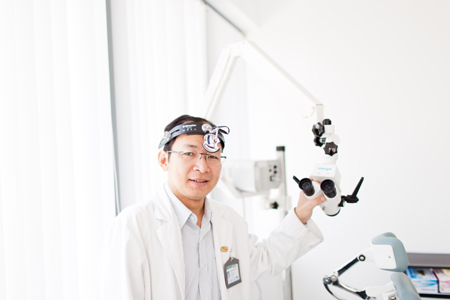High technology applications in the field of facial rejuvenation worldwide have helped patients to receive successful treatment, and have a better quality of life.
FV Hospital is renowned for performing such advanced techniques, especially in cases where the lower jaw is reconstructed using fibula flap microsurgery grafts from the legs.
Dr Nguyen Quang Dai, Head of FV Hospital’s Ear Nose and Throat Department, has successfully performed this microsurgery for male patient H.V.T., in February 2017.
H.V.T., 61, a freelance worker living in Phu Nhuan District, was diagnosed with osteonecrosis of the lower jaw at FV Hospital. Dr Dai says that the cause of his jaw bone osteonecrosis may resulted from a prolonged tooth infection that eventually reached the jaw bone. Dr Dai also reveals that the fibula of each person is actually a natural reserve for his or her own bones as it can be restored to its former state after being harvested.

Mr. H. V. T.’s surgery took seven hours. Dr Dai and his team cut open the trachea, removed the necrotic jaw bone, and took a graft from Mr. T’s fibula to recreate the removed bone. Bone grafting helps to recreate the normal facial contour and the new jaw will be nurtured by the patient’s blood vessels so it will still be a living bone, which is much better for the body than using an artificial replacement. This technique also allows tooth restoration by implants, which also improves patient’s chewing function as well as restoring a natural smile to his or her face.
Dr Dai predicts the patient will recover fully within eight weeks. Dr Dai said FV Hospital has received similar cases in the past, all of which were treated successfully. Bone reconstruction using the fibula is a highly complex technique, requiring a well-trained surgeon who is particularly skillful and adept at ensuring the aesthetics of the transplant, and who has cutting edge medical equipment at their fingertips.
FV Hospital’s operating theatres fully meet these stringent requirements. Patients suffering from diseases that require facial rejuventation, if not treated with this microsurgical technique, must accept living with a disability; if they receive standard methods of jaw reconstruction using articifical prosthetics, the aesthetics are not usually guaranteed.
The day after the surgery, Dr Dai went to visit the patient in his room and also spent some time talking gently with his wife and daughter. The whole family felt much more reassured when they were able to share in their beloved one’s illness.
“Successful treatment for patients must be accompanied with the ability to give them a meaningful life. It is most pressing aspiration of my medical career,” shares Dr Dai.



